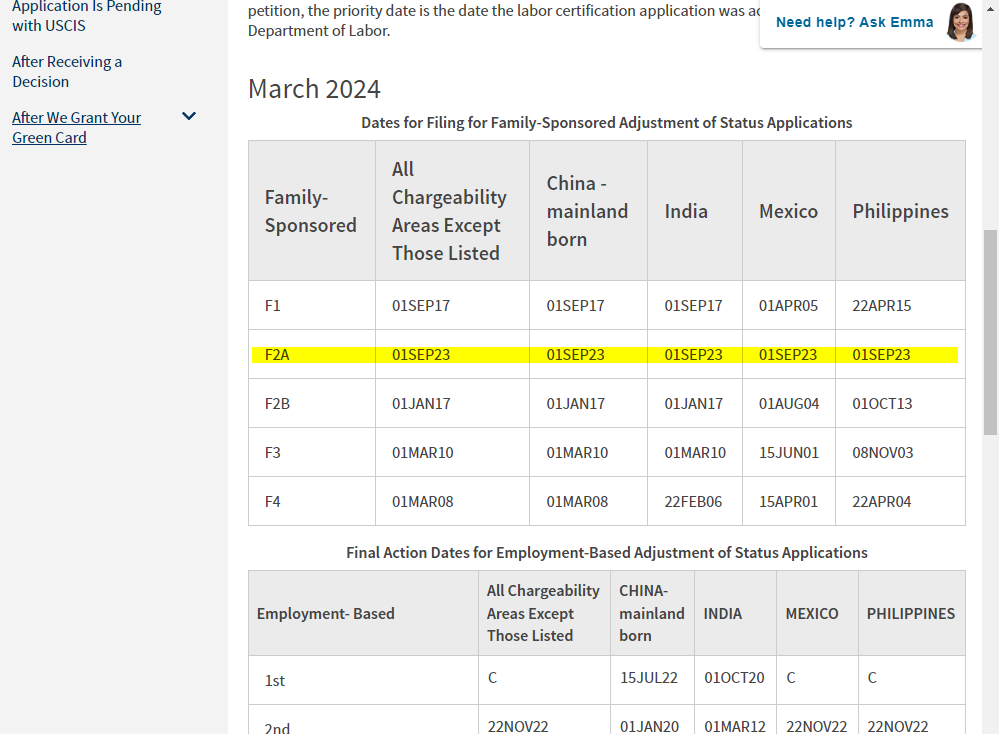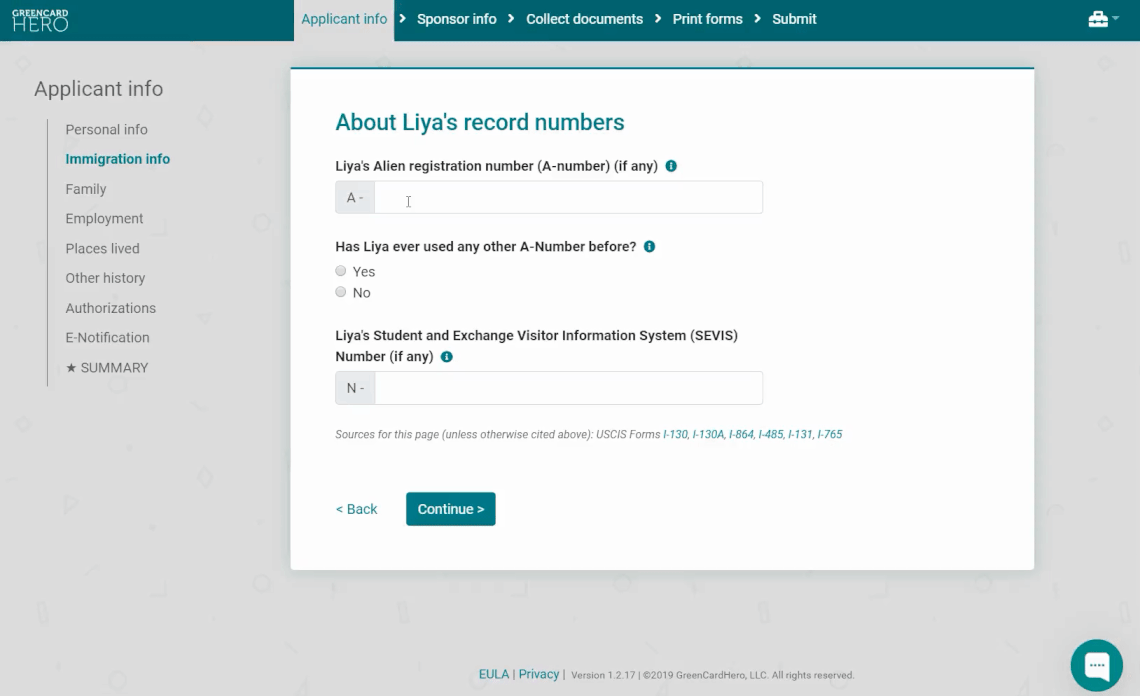Congratulations on your marriage! This guide is for people who want to get a marriage green card for their wife or husband. We will explain everything you need to successfully complete the application process. For most couples, the application is straightforward and does not need a lawyer. Instead, save that $4,000 lawyer’s fee for your lovely honeymoon on the beach. Did you know this cool guide makes a satisfying beach read? 🌴
Table of Contents
1. Marriage Green Card Process Overview
Note: This guide is for the spouse of a U.S. citizen or of a green card holder. In addition, the applicant should be inside the U.S. when applying (If you will apply from outside the U.S, use our other in-depth guide instead.)
If you are the spouse of a U.S. citizen or green card holder, and you currently live in the U.S, you and your spouse will need to file a Petition for Alien Relative and an Adjustment of Status through marriage[1] [2] (Don’t run, you will become an expert in this in the next five minutes).
Total government filing fee: $1,760 (if file before April 1, 2024) or $2,115 – $3,005 (if file on or after April 1, 2024).
Total processing time: For a U.S. citizen’s spouse: 10-14 months;For a green card holder’s spouse: Around 4 years (The wait time has been fluctuating due to the recent visa bulletin F2A final action date retrogression. It may improve over time to 2-3 years.)
The application process can be broken into two steps:
Step 1: The Paper Party – Submit Forms and Documents to USCIS
We kick off the party with forms and documents!
The process is slightly different for spouses of U.S. citizens versus spouses of green card holders. So we will explain them separately:
The application will require the following forms:
- Form I-130 – Petition for Alien Relatives
- Form I-130A – Supplemental Information for Spouse Beneficiary
- Form I-485 – Application to Register Permanent Residence or Adjust Status
- Form I-864 – Affidavit of Support Under Section 213A of the INA
- Form I-765 – Application for Employment Authorization (optional)
- Form I-131 – Application for Travel Document (optional)
- G-1145 – e-Notification of Application/Petition Acceptance (optional)
- Form I-944 – Declaration of Self Sufficiency (A new form that came into effect on February 24, 2020 due to USCIS’ new Public Charge Rule) [💡: This form is no longer needed due to the cancellation of the Trump-era Public Charge rule.]
Forms will be explained in details in the forms section of this guide.
December 23, 2022 Update: Starting December 23, 2022, USCIS will implement the new Biden-era Public Charge rule and stop accepting previous editions of Form I-485. Instead, it will switch to a new Form I-485, which will contain additional questions compared to the previous editions. So please double check that your Form I-485 edition is correct when submitting your application.
You also will need to submit the following supporting documents alongside the forms:
- Passport-style photos of both spouses
- Proof of the sponsor’s U.S. citizenship (e.g. U.S. passport, naturalization certificate)
- Proof of the applicant’s immigration status
- Current marriage certificate and documents of prior marriages
- Evidence of joint activities
- The applicant’s proof of financial support
- The applicant’s medical examination result
- The applicant’s birth certificate
- The applicant’s proof of self-sufficiency [💡: No longer needed due to the cancellation of the Trump-era Public Charge rule]
Documents will be explained in details in the documents section of this guide.
USCIS charges an application fee of $1,760 (if file before April 1, 2024) or $2,115 – $3,005 (if file on or after April 1, 2024). [1] [2] (more details in the fees section).
Submit your application as one package to USCIS through mail [1] [2].
Come meet our new friends: 9 government forms in total, 5 are required and 4 are optional. You’ll need to submit them in two parts, with a waiting period between Part One and Part Two.
Application Part One (Officially Called Petition for Alien Relative)
Forms to submit:
- Form I-130 – Petition for Alien Relatives
- Form I-130A – Supplemental Information for Spouse Beneficiary
- G-1145 – e-Notification of Application/Petition Acceptance (optional)
Forms will be explained in details in the forms section of this guide.
Supporting documents:
- Passport-style photos of both spouses
- Proof that the sponsor is a U.S. permanent resident (e.g. U.S. permanent resident card)
- Current marriage certificate and documents of prior marriages
- Evidence of joint activities
USCIS filing fee: $535 (if file before April 1, 2024) or $675 (if file on or after April 1, 2024) [1]
Submit your application as one package to USCIS through mail [1].
It will take about 12-15 months for USCIS to approve Application Part One. Then, you’ll likely have to wait for another 2 weeks for a Green Card to become available. After that, you can finally submit Application Part Two. (More on the waiting time later.)
Application Part Two (Officially Called Adjustment of Status)
Forms to submit:
- Form I-485 – Application to Register Permanent Residence or Adjust Status
- Form I-864 – Affidavit of Support Under Section 213A of the INA
- Form I-765 – Application for Employment Authorization (optional)
- Form I-131 – Application for Travel Document (optional)
- G-1145 – e-Notification of Application/Petition Acceptance (optional)
- Form I-944 – Declaration of Self Sufficiency (A new form that came into effect on February 24, 2020 due to USCIS’ new Public Charge Rule) [💡: This form is no longer needed due to the cancellation of the Trump-era Public Charge rule.]
December 23, 2022 Update: Starting December 23, 2022, USCIS will implement the new Biden-era Public Charge rule and stop accepting previous editions of Form I-485. Instead, it will switch to a new Form I-485, which will contain additional questions compared to the previous editions. So please double check that your Form I-485 edition is correct when submitting your application.
Supporting documents:
- Passport-style photos of the applicant
- Proof of the applicant’s immigration status
- The applicant’s proof of financial support
- The applicant’s medical examination result
- The applicant’s birth certificate
- The applicant’s proof of self-sufficiency [💡: No longer needed due to the cancellation of the Trump-era Public Charge rule]
USCIS filing fee: $1,225 (if file before April 1, 2024) or $1,440 – $2,330 (if file on or after April 1, 2024)[2]
Submit your application as one package to USCIS through mail [2]. This concludes Step 1 and we now move into Step 2.
Later in this guide, we’ll explain everything you need to know (and some more) about forms, documents, fees and mailing it out.
Step 2: The Waiting Game – Wait until the Interview and the Green Card Approval
No more paperwork at this point! Now it’s mostly waiting around until you receive a Green Card interview notice around 10-14 months later [3]. The interview will take place at a USCIS office near you, and both spouses need to attend in-person. (More on the interview later.) If everything goes well, you will receive your Green Card approval at the end of the interview, and within another month, your Green Card will arrive in the mail!
The timeline section will explain the waiting process in detail.
How to complete your green card application in 7 days?
Get our exclusive 7-Day Action Plan:
2. Make Sense of the Process
Why all these forms and documents? In this section, we explain the Green Card application logic that routinely confuses the world’s smartest rocket scientist. Once you understand the logic behind it, this process will make a lot more sense.
To begin, let’s meet Arnold and Maria:

Applicant: Arnold is 28 years old and hails from the snowy mountains of Austria. Arnold is not a U.S. citizen and is applying to receive a Green Card.

Sponsor (also known as a petitioner): Maria is 27 years old and is a native to the sunny Southern California. She is married to Arnold and is a U.S. citizen or green card holder.
After getting married, Arnold and Maria started researching how to apply for a marriage Green Card for Arnold.
For couples like Arnold and Maria, the application paperwork contains two parts:
🔑 Application Part One: Establish Arnold’s Eligibility for a Green Card (Officially Called “Petition for Alien Relative”. We will call it “immigrant petition” in this guide.)
Since Arnold’s eligibility is based on his marriage to Maria, Maria needs to complete Application Part One (immigrant petition) to demonstrate [1]:
- Maria is a real person.
- Maria is a U.S. citizen.
- Arnold is her husband.
- Their marriage is real.
This step is mostly for Maria to complete.
🌱 Application Part Two: Apply for Arnold’s Green Card (Officially Called “Adjustment of Status to Lawful Permanent Resident”. We will call it “adjustment of status” in this guide.)
After the immigrant petition has established Arnold’s Green Card eligibility, now Arnold can apply for it. Application Part Two (adjustment of status) collects information that demonstrates [2]:
- Arnold is a real person.
- Arnold’s current immigration status doesn’t bar him from receiving a Green Card.
- Arnold can financially support himself in the U.S. without government assistance.
- Arnold is in good health.
- Arnold has no criminal history.
This step is mostly for Arnold to complete.
USCIS processes the forms and documents for the immigrant petition (Application Part One) independently from those for the adjustment of status (Application Part Two) [1] [2], so we need to separate the paperwork of each part when we submit the application (more on that in the submit section of this guide). In the next section, we will explain all the forms, documents and filing fees you need.
For couples like Arnold and Maria, here is the application paperwork timeline:
🔑 Application Part One: Immigrant Petition
Part One’s purpose is to establish Arnold’s eligibility for a Green Card. Since Arnold’s eligibility is based on his marriage to Maria, Maria needs to complete the Application Part One to demonstrate [1]:
- Maria is a real person.
- Maria is a U.S. permanent resident.
- Arnold is her husband.
- Their marriage is real.
This part is mostly for Maria to Complete.
Around 2 Weeks Later
USCIS Receipt Notice (Form I-797) Arrives
The receipt notice confirms that USCIS has received your Application Part One. It contains a case number, which you can use to track your Part One case status with the USCIS Case Status Checker. It also contains a date labeled “Priority Date”. You will use this date later to determine when to submit Application Part Two.
Waiting period until a visa number becomes available
Good news — in August 2023, there is no wait time! So you can move onto submitting the adjustment of status application immediately after receiving I-130 Receipt Notice. This zero wait time will last until the end of August. Starting September 2023, Submission 1 and Submission 2 need to be submitted separately in sequence. ⏰
🌱 Application Part Two: Adjustment of Status
Part Two’s purpose is to apply for Arnold’s Green Card. After USCIS approves Part One, Arnold has successfully established his Green Card eligibility; now he can apply for it. The Application Part Two collects information that demonstrates [2]:
- Arnold is a real person.
- Arnold’s current immigration status doesn’t bar him from receiving a Green Card.
- Arnold can financially support himself in the U.S. without government assistance.
- Arnold is in good health.
- Arnold has good moral characters.
This part is mostly for Arnold to Complete.
Around 2-3 Weeks after Filing Part Two
USCIS Receipt Notices (Form I-797) Arrive
For each form you submit in Application Part Two, you will receive a receipt notice from USCIS. Each receipt notice contains a case number. You can use these case numbers to track your Part Two case status with the USCIS Case Status Checker.
For the Next 8-10 Months after receiving USCIS Notice of Approval
Mostly Waiting until Receiving Green Card Interview Notice
This is where Step 2 – the Waiting Game begins. We will explain what happens during this time in the timeline after filing section later.
Why the wait before submitting Part Two?
The answer: Arnold cannot apply for a Green Card, until a Green Card becomes available for him to apply to.
This may sound very strange, until you learn this fact: the U.S. government only gives out a fixed number of Green Cards each year, no matter how many people are eligible for it. So when there are more eligible people than there are Green Cards, some people have to wait until a new batch of Green Cards become available. 1
When can I submit Application Part Two?
You can find out by checking the USCIS Visa Bulletin information page, which updates once a month. Click on the link to the current month, and in the chart find category “F2A”.

If the date on the chart is current (“C”), or your priority date (explained below) is earlier than the date on the chart, you may file Application Part Two. Otherwise, you will need to continue waiting and check the bulletin page again next month. 2
What's Priority Date?
You can find your Priority Date on the Form I-130 Receipt Notice (Form I-797) you received earlier. The date is under a column labeled "Priority Date". 3
3. USCIS Application Forms
There are 9 forms in total, to be submitted in two separate packets. Five forms are required and the other four are optional. Let’s take a look at what these forms are for:
🔑 Forms for Application Part One: Immigrant Petition
- Form I-130 – Petition for Alien Relatives [Maria to fill out] No, this isn’t about your aunt Barb who claims to be an extraterrestrial 👽. Maria needs to fill out this form to confirm she is a U.S. citizen and Arnold is her husband. It asks for information about both Maria and Arnold.
- Form I-130A – Supplemental Information for Spouse Beneficiary [Arnold to fill out] Enter Arnold’s information for a second time. Only this time it’s Arnold’s turn to fill it out.
- Form G-1145 – e-Notification of Application/Petition Acceptance (optional) [Maria to fill out] Ever dreamed of getting a ping from USCIS on the phone? 💌 Fill in this form to request an electronic notification when USCIS accepts the immigrant petition.
🌱 Forms for Application Part Two: Adjustment of Status
- Form I-485 – Application to Register Permanent Residence or Adjust Status [Arnold to fill out] Arnold, please stretch your fingers. 🖐 You are about to enter your information for a third time here. And don’t forget the 66 check boxes at the end for questions such as “Does Arnold intend to sabotage the United States?”.
- Form I-864 – Affidavit of Support Under Section 213A of the INA [Maria to fill out] Affi what? Who is David?🧜Well, it’s actually a form to show Arnold can financially support himself in the U.S. without government assistance. The simplest way to do so is if Maria can demonstrate that her income is at least 125 percent of the current Federal Poverty Guidelines for Maria’s household size (only 100 percent of the Guidelines if Maria is on active duty in the U.S. Armed Forces or U.S. Coast Guard). If this is not the case, the form instruction outlines other ways for Arnold and other relatives to chip in. Yeah… this form is definitely the most confusing one. So make sure to spend some time understanding the form instructions.🤷
- Form I-765 – Application for Employment Authorization (optional) [Arnold to fill out] Arnold needs to do this form if he wants to work in the U.S.while his application is pending. (Arnold wants to continue his employment with Skyweb 😎, so he fills out the form.)
- Form I-131 – Application for Travel Document (optional) [Arnold to fill out] Arnold needs to do this form if he wants to travel outside of the U.S. while his application is pending. (Arnold needs to fly to Maluku to terminate a tasselled wobbegong 🐡, so he fills out the form.)
- G-1145 – e-Notification of Application/Petition Acceptance (optional) [Arnold to fill out] Fill in this form to request an electronic notification when USCIS accepts the adjustment of status.
- Form I-944 – Declaration of Self Sufficiency [Arnold to fill out]
This is a new form added due to the new USCIS Public Charge rule. Arnold needs to fill out detailed information regarding his income, tax returns, family members, credit score, assets, debts & liabilities, health insurance, and education. Oh well, guess he’s got no other choice but to tell USCIS everything… 😭 [💡: No longer needed due to the cancellation of the Trump-era Public Charge rule]
How to make sure I filled out the forms correctly?
Each USCIS form comes with an instruction [1] [2] [4] [5] [6] [7]. Make sure you carefully review the instructions. I know, I know – those instructions are written in Austrian Martian. Even the killer robot from the future cannot survive the grandeur of 132 pages of full-length legal verbiage without dropping cold onto the floor.

If you are like Arnold, you may dream about doing your application the TurboTax style: fill out a simple questionnaire with step-by-step instructions, and boom!, your forms are completed for you.
Good news – here at GreenCardHero, we have created a useful Green Card application software which does exactly that for you: 😃
Get Your Marriage Green Card. Fast. Easy. Affordable.
Complete your entire application with easy step-by-step instructions. From filling out forms, collecting supporting documents, to submission and receiving green card. Start your application today!
“This software has helped me save thousands of dollars from hiring lawyers. The instructions are super clear, easy to follow and it’s affordable.”
— Brandon T
4. Document Checklist
USCIS requires many supporting documents and the list varies from person to person. The number of documents needed ranges between 13 and 47 (or more). In this section, we will first briefly describe the various document categories. Then, we have prepared a detailed interactive checklist to help you fully understand all the required documents. Let’s get started!
🔑 Documents for Application Part One: Immigrant Petition
- Arnold’s and Maria’s passport-style photos
Passport-style photos of both Arnold 🦊 (2 copies) and Maria 🐰(2 copies), taken within 30 days of filing the application - Proof of Maria’s U.S. citizenship or Lawful Permanent Residence Status
e.g. U.S. passport, naturalization certificate, certificate of citizenship, U.S birth certificate, U.S. Permanent Resident Card 🔖 - Marriage papers
Current marriage certificate and prior marriage termination documents 📑 - Evidence of Arnold and Maria’s joint activities
Documents that prove the marriage is real. 💑 For example, joint ownership of property, joint apartment lease, birth certificates of children you had together, photo collection.[1]
🌱 Documents for Application Part Two: Adjustment of Status
- Arnold’s passport-style photos
Passport-style photos of Arnold 🦊 (2 – 6 copies depending on the case), taken within 30 days of filing the application. Did you notice USCIS really loves immigrants’ photos? - Arnold’s birth certificate
Arnold’s birth certificate 🐣 - Proof of Arnold’s immigration status
Evidence of continuously maintaining a lawful status since arrival in the U.S. 🤟 - Arnold’s proof of financial support
E.g. (If Maria is Arnold’s financial sponsor in Form I-864) Maria’s pay stubs, Maria’s tax returns, Maria’s letter from employer🤑 - Arnold’s proof of self-sufficiency
This section is a new type of black hole generated by the new Form I-944. This hole’s unprecedented vast range extends to proof of family relationship in the south, high school language course grades in the north, real estate appraisal in the east, and health insurance policy in the west. There are no documents that USCIS cannot ask for – the only limit is your imagination. [💡: No longer needed due to the cancellation of the Trump-era Public Charge rule] - Arnold’s medical examination result
Form I-693 – Report of Medical Examination and Vaccination Record . This form will be filled out by the doctor who provides you with the exam. At the end of the exam, the doctor will hand you the filled out Form I-693 in a sealed envelop. Do not open the envelope and mail it together with the rest of Application Part 2 to USCIS.) ⚕ - U.S. Citizen’s Spouse Does not Need This Form I-130 Receipt or Approval Notice (called Form I-797)
Around 2 weeks after Maria filed Form I-130 in Application Part One, Maria should have received a Form I-130 receipt notice from USCIS.
📄 GreenCardHero’s comprehensive list of application documents – Click on each document category to see all the documents you need:
The sponsor is a:
(If the checklist below displays blank, click here to see.)
5. USCIS Filing Fees
If file before April 1, 2024: USCIS charges a total of $1,760 for filing fees, paid in two separate checks/ money orders. Make each check/ money order payable to “U.S. Department of Homeland Security”.
If file on or after April 1, 2024: USCIS charges a total of $2,115 – $3,005 for filing fees, paid in 2 – 4 separate checks/ money orders. Make each check/ money order payable to “U.S. Department of Homeland Security”.
🔑 Filing Fee for Application Part One: Immigrant Petition
One check/ money order $535 (if file before April 1, 2024) or $675 (if file on or after April 1, 2024) Form I-130
🌱 Filing Fee for Application Part Two: Adjustment of Status
First check/ money order If file before April 1, 2024: Filing fee for Form I-485 ($1,140) + Biometric services fee ($85), paid a total of $1,225 using one check/money order If file on or after April 1, 2024: Filing fee for Form I-485 $1,440 Second check/ money order If file before April 1, 2024: Not needed If file on or after April 1, 2024: Filing fee for Form I-765 $260 Third check/ money order If file before April 1, 2024: Not needed If file on or after April 1, 2024: Filing fee for Form I-131 $630
Is the complexity level of your case suitable for DIY?
Immigration history, income, marriage time and criminal records are all factors.
Take our eligibility quiz to find out in 40 seconds:
6. Assemble and File the Application
We are all done with the hard part! Now let’s stuff this delicious paperwork feast in a hungry envelope! 📩
Submit in One Envelope, but as Two Packets
The immigrant petition and the adjustment of status can be submitted together in the same envelope. This is called “concurrent filing” and is a special privilege given to U.S. citizens’ immediate relatives (including the spouse) who are already living in the U.S. [8]. Most other Green Card applicants have to patiently wait until the immigrant petition is approved by USCIS before submitting the adjustment of status. So lucky you!
Even though these two parts are submitted together, USCIS processes them separately [8]. Therefore, to avoid grumpy USCIS agents, kindly organize the paperwork into two separate application packets.

Cover Each Packet with A Cover Letter
Time to organize, kids! USCIS recommends creating a cover letter for each application packet and placing the cover letter on top of the packet. A cover letter is essentially a table of contents of all the forms and documents contained within the packet. The cover letter helps you organize your papers, and also helps USCIS agents during their review.
If you are using GreenCardHero, GreenCardHero will create a customized cover letter for each of your application packet, making your submission fast and easy.

Stack and Stuff
Now stack your forms and documents in the order listed on the cover letter. Then put the assembled packet in one envelop/package. Your application is now ready to send!
Where to Send
Finally, it’s time to mail the application package! 📩 Mail the envelope to USCIS at the address below [10] [11].
If you mail through U.S. Postal Service (USPS), depending on the state where the applicant lives, the mailing address is one of the following:
USCIS Attn: AOS P.O. Box 805887 Chicago, IL 60680 OR USCIS Attn: AOS P.O. Box 20500 Phoenix, AZ 85036-0500
If you mail through FedEx, UPS, and DHL, depending on the state where the applicant lives, the mailing address is one of the following:
USCIS Attn: AOS (Box 805887) 131 South Dearborn - 3rd Floor Chicago, IL 60603-5517 OR USCIS Attn: AOS (Box 20500) 1820 E. Skyharbor Circle S Suite 100 Phoenix, AZ 85034-4850
Now we’ve got a lot of finished paperwork lying around, how do we organize and submit it? It’s time to learn the subtle art of stuffing hungry envelops. 📩 The process is the same for both Application Part One and Part Two.
Organize Using a Cover Letter
Per the USCIS recommendation, we will create a cover letter and place it on top of the application packet.[6] A cover letter is essentially a table of contents for all the forms and documents contained in an application. A cover letter helps you organize your papers, and also helps you avoid grumpy USCIS agents during processing.
If you are using GreenCardHero, GreenCardHero will create a customized cover letter for each of your submission, making assembling the application fast and easy.
Stack and Stuff
Now stack your forms and documents in the order listed on the cover letter. Then put the assembled packet in one envelop/package. Your application is now ready to send!
Mail It!
Finally, it’s time to mail the application package! 📩 The mailing address for Submission 1 and Submission 2 are different. Make sure you use the correct address for each submission.
- Application Part One (Immigrant Petition): follow the USCIS Form I-130 filing address
- Application Part Two (Adjustment of Status): follow the USCIS Form I-485 filing address

How to Catch Mistakes before Filing
- First, take a deep breath. Hundreds of thousands of couples just like you apply for their Green Cards every year, and the vast majority get approved. The odds are on your side!
- Review each application form, document and cover letter.
- If you’re iffy about any particular section, try re-reading the form’s instructions for that section.
- If you to check more closely, consider hiring an immigration lawyer to review your completed application. An application review is affordable, usually costs around $500. In contrast, hiring a lawyer to do the whole application for you can cost $4,000 and up.
7. Application Timeline
Yay, you filed! The hardest part is officially behind us! Now we move on to the second – and final – step of the process: “Game of Groans”. The groans are caused by prolonged waiting: once in a while, your application reaches a milestone and you receive a USCIS communication, and then you wait some more, until you get a notice for an interview. Eventually, you will receive that gorgeous Green Card in the mail.
This timeline explains what happens after filing the Green Card application:
Around 2-3 Weeks after Filing
USCIS Receipt Notices Arrive
For each form you submit in the application, you will receive a receipt notice from USCIS. Each receipt notice contains a case number. You can use these case numbers to track your case status with the USCIS Case Status Checker.
Around 3-5 Weeks after Filing (maybe slower due to COVID-19)
Biometrics Appointment Notice Arrives for the Applicant
The biometrics services appointment is a quick, low stress procedure where the USCIS takes the applicant’s fingerprints, photograph, and/or signature. This helps USCIS confirm the applicant’s identity and run required background and security checks.4
The appointment will be at a local USCIS Application Support Center (ASC). The applicant’s appointment notice will include the date, time and location for the appointment.5
Download GreenCardHero to see the complete application timeline
Around 4-6 Weeks after Filing (maybe slower due to COVID-19)
The Applicant Goes to the Biometrics Appointment
Attend the scheduled biometrics services appointment. You can learn more about what it’s like on the USCIS website.
8. Track Case Status and Processing Time
USCIS Case Status Checker is the official tool for checking your case status. Enter all the case numbers printed on the receipt notices you received, then the tool will display the processing status of each form in your particular case.
You may also use the official USCIS Case Processing Times Checker to see the current processing time of each form, so that you can anticipate when your case status will change. The processing time has been steadily increasing since Trump became president in 2017, and it varies significantly depending on where you live. The tool shows the processing time range for each form type at different USCIS office locations.
How to Preserve Sanity During the Wait

Based on my personal experience, the long wait can get very frustrating – feeling suspended in uncertainty is not fun. Unfortunately, none of us can speed up processing speed (except President Biden perhaps?).
I found it helpful to join an online immigration forum and feel like part of a community that is going through this together. I also found it helpful to keep myself engaged with other activities in life, so I wouldn’t think about “the G” (“g” from Green Card) that much.
Ultimately, the time will come when a fateful USPS letter arrives in your mailbox. You pick it up and feel a thin and sturdy object inside, perfectly rectangular with slight rounded edges. You carefully open the envelope, and there it is – a Green Card, shrouded in an ornate tapestry and soft hues; through a fine layer of misty Atlantic fog, the statue of liberty greets you with a gorgeous smile. This journey has made you older and wiser, and congratulations, you’ve now got the key to America!

Join 27 Couples Who Applied Today

Related Posts
- https://travel.state.gov/content/travel/en/legal/visa-law0/visa-bulletin/2019/visa-bulletin-for-january-2019.html
- https://www.uscis.gov/visabulletininfo
- https://www.uscis.gov/greencard/visa-availability-priority-dates
- https://www.uscis.gov/forms/forms-information/preparing-your-biometric-services-appointment
- https://www.uscis.gov/forms/forms-information/preparing-your-biometric-services-appointment

